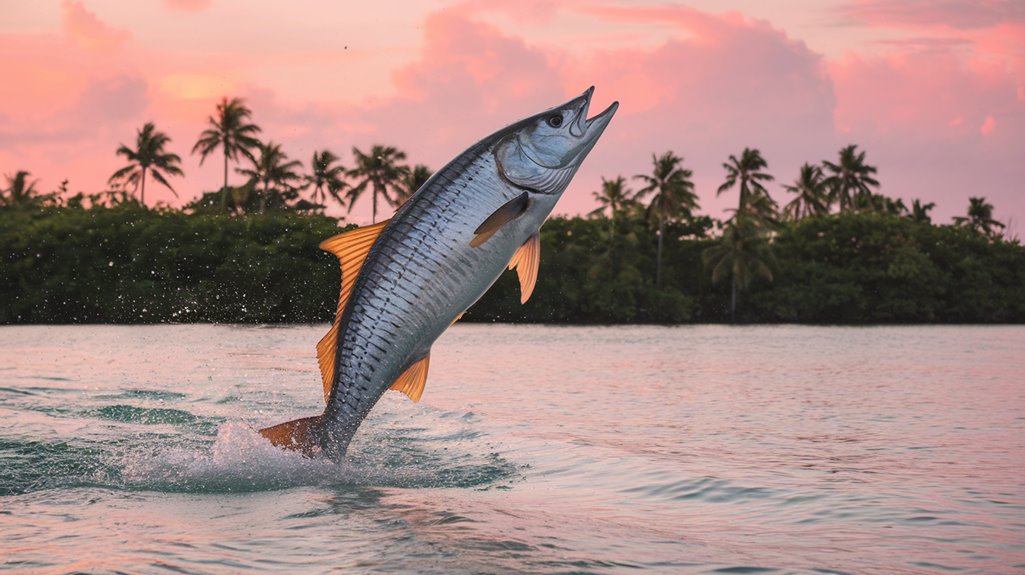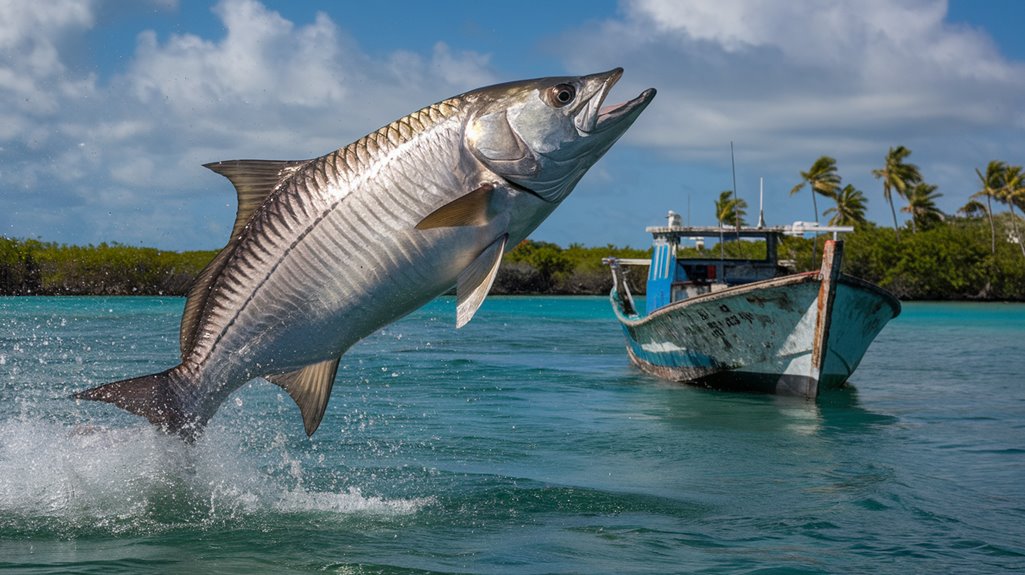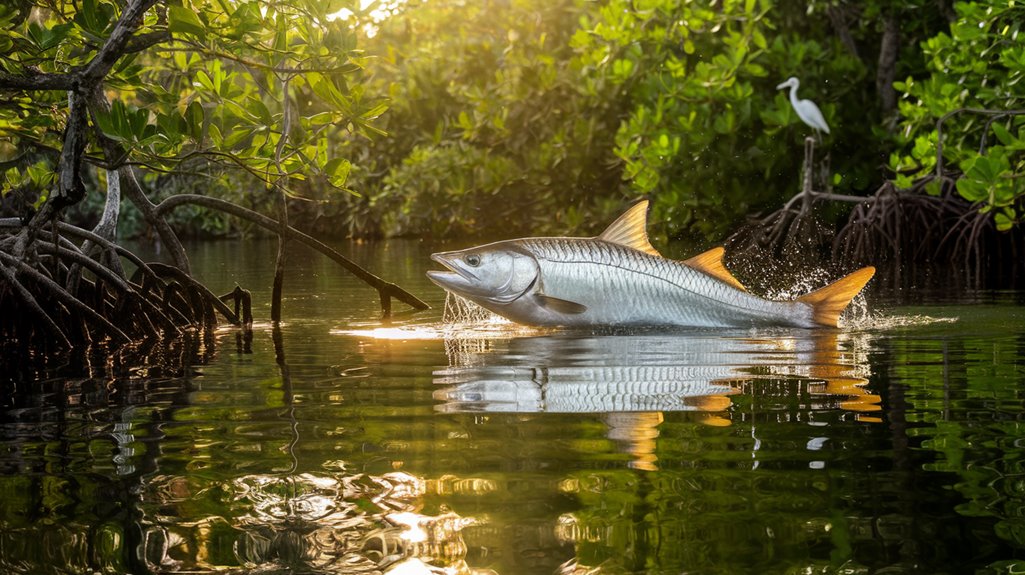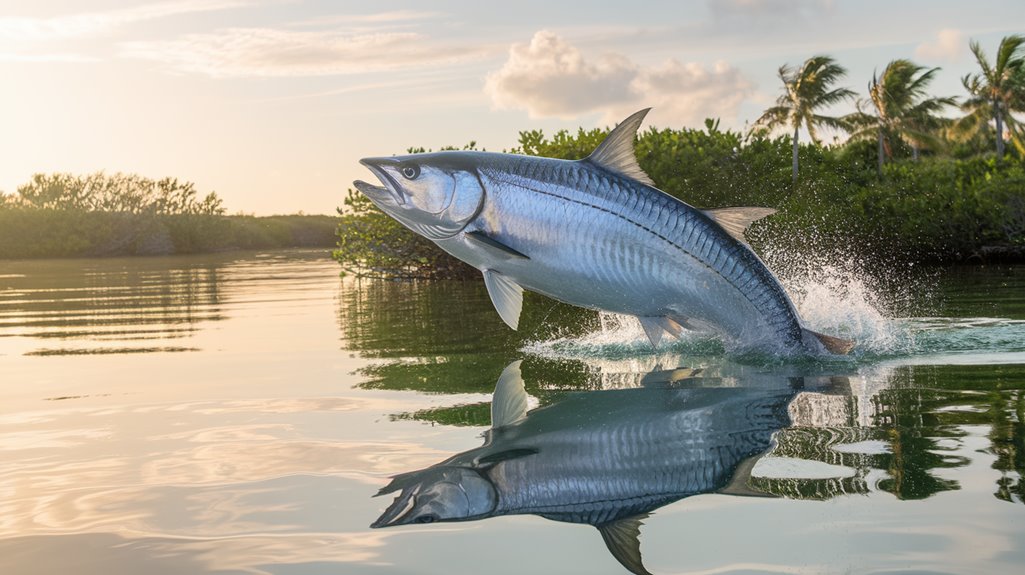When you're pursuing the silver king, you'll need more than just your 12-weight fly rod and a box of cockroach patterns. Location and timing are critical factors that'll determine your success rate with tarpon. From Florida's crystalline flats to Cuba's remote archipelagos, each premier destination offers unique challenges and rewards. Whether you're sight-casting to rolling fish in Islamorada or working the channels in Belize, understanding these world-class fisheries will transform your approach to targeting trophy tarpon.
- Key Takeaways
- The Legendary Waters of Islamorada, Florida
- Cuba's Hidden Gem: Jardines De La Reina
- Exploring Belize's Rich Tarpon Grounds
- Key West's Premier Tarpon Spots
- Mexico's Yucatan Peninsula Hotspots
- Costa Rica's Caribbean Coast Treasures
- Miami's Urban Tarpon Paradise
- Everglades National Park's Silver Kings
- Frequently Asked Questions
- Conclusion
Key Takeaways
- Islamorada, Florida offers world-class tarpon fishing from April through July with exceptional sight fishing along Atlantic Coast flats.
- Cuba's Jardines De La Reina provides pristine waters for targeting tarpon between 8-80 pounds in a protected marine sanctuary.
- Belize's 200-mile coastline features both resident and migratory tarpon populations, with peak fishing from April through September.
- Mexico's Yucatan Peninsula hosts baby tarpon in San Felipe's mangroves and trophy-sized specimens in Ascension Bay.
- Miami's urban fishery provides year-round tarpon opportunities around Biscayne Bay's bridges, deep channels, and Government Cut.
The Legendary Waters of Islamorada, Florida

The legendary waters of Islamorada stand as a proof to world-class tarpon fishing, drawing seasoned anglers to its productive flats and channels during the peak migration months of April through July. You'll find exceptional sight fishing opportunities along the Atlantic Coast flats and Florida Bay, where both novice and veteran anglers can target these magnificent gamefish. During the migratory season, you can position yourself at strategic sand bars and outer flat edges, where resident tarpon congregate in significant numbers. From March through early fall, you'll discover productive live-baiting opportunities at local bridges, while the diverse fishing environments of Islamorada's oceanside and backcountry waters offer you multiple tactics to pursue these silver kings throughout the season.
Cuba's Hidden Gem: Jardines De La Reina
Located off Cuba's southern coast, Jardines de la Reina presents you with an untouched marine sanctuary where tarpon fishing reaches its purest form. You'll find pristine flats and channels teeming with tarpon ranging from 8 to 80 pounds, while aggressive juvenile tarpon under 30 pounds provide consistent action.
When targeting these waters, you'll want to:
- Pack 9-weight rods for juvenile tarpon in the mangroves
- Bring 11-weight setups for larger specimens in deeper channels
- Stock both floating and intermediate sink-tip lines for varied conditions
While planning your trip requires managing travel restrictions, the remarkable fishing opportunities make it worthwhile. The protected environment demands strict adherence to conservation efforts, ensuring this fishery remains a premier destination for serious anglers seeking world-class tarpon action.
Exploring Belize's Rich Tarpon Grounds

Moving from Cuba's pristine waters, seasoned anglers will find Belize's 200-mile coastline equally compelling for world-class tarpon fishing. You'll encounter both resident and migratory tarpon populations, with peak season running April through September when 30-100 pound specimens frequent the coastal waters.
| Location | Fishing Characteristics |
|---|---|
| Ambergris Caye | Sight fishing, flats |
| Mangrove Estuaries | Mixed size tarpon |
| Coastal Rivers | Migration routes |
| Belize River Lodge | Guide expertise |
| Southern Flats | 40-60 pound average |
The historic Belize River Lodge, operating since 1961, serves as your gateway to prime fishing opportunities. Whether you're targeting the flats of Ambergris Caye or exploring southern mangrove estuaries, you'll find consistently productive waters throughout the year-round season.
Key West's Premier Tarpon Spots
You'll find Key West's most productive tarpon action in the harbor channels after sunset, where strategic positioning near bridge pilings can yield 100-pound-plus fish during slack tide. During morning tides, work the flats with live mullet or pinfish, focusing on the clear, shallow waters where you can sight-cast to cruising fish. Bridge fishing peaks during the first two hours of incoming tide, when you should position your boat up-current and deploy live crabs or threadfin herring near the shadow lines.
Harbor Channels After Dark
As darkness descends over Key West's harbor channels, seasoned anglers position themselves near the docks and bridges where tarpon congregate to feed. Your best chances for success come during slack tide, when these magnificent fish actively pursue prey in the low-light conditions. While tarpon fishing peaks from April to July, night fishing produces stellar results year-round.
To maximize your success in these productive waters:
- Target areas where channel currents intersect with dock structures
- Use fresh live bait, particularly mullet or crabs, to match natural feeding patterns
- Position your vessel quietly to avoid spooking fish in the channels
The harbor's strategic locations offer prime opportunities to sight-fish for tarpon, especially as they become more active in the evening hours, creating unforgettable fishing experiences against Key West's illuminated backdrop.
Flats During Morning Tides
The shallow flats surrounding Key West transform into prime tarpon territory during morning slack tides, when these silver kings prowl the skinny water in search of prey. You'll find the best fishing waters between the islands, particularly around Seven Mile Bridge and the backcountry flats, where sight fishing opportunities abound. Targeting these spots during early morning tides maximizes your chances of success.
| Location | Best Time | Technique |
|---|---|---|
| Seven Mile Bridge | Dawn-8AM | Live Bait |
| Backcountry Flats | Slack Tide | Sight Fishing |
| Island Channels | Morning | Large Plugs |
When you're working the flats, be ready for explosive action. These shallow water giants often exceed 100 pounds and put on spectacular aerial displays. Pack heavy-duty gear and position yourself strategically during morning tides for ideal results.
Bridge Fishing Peak Times
During winter and early spring, Key West's iconic bridges transform into premier tarpon hotspots, with Government Cut leading the pack for consistent action. You'll find ideal conditions during slack tide, which occurs twice daily, providing perfect feeding opportunities for these mighty fish.
Key factors for successful bridge tarpon fishing:
- Time your fishing around early morning and late afternoon peak hours
- Focus on the April-July migration period at Seven Mile and Bahia Honda bridges
- Position yourself for sight fishing during changing tides
For the best results, prepare for extended battles when targeting these acrobatic fighters. Whether you're working Government Cut or the bridges, remember to properly revive your catch before release. The slack tide periods are your prime windows, so plan your sessions accordingly to maximize your chances of hooking these magnificent gamefish.
Mexico's Yucatan Peninsula Hotspots
Savvy anglers seeking world-class tarpon action won't find a better destination than Mexico's Yucatan Peninsula. You'll discover prime baby tarpon opportunities in San Felipe's mangrove lagoons, where 5-25 pound fish readily take flies. For trophy hunters, Ascension Bay and Xcalak deliver resident monsters in the 30-100 pound range.
| Location | Target Size | Peak Season |
|---|---|---|
| San Felipe | 5-25 lbs | Apr-Sep |
| Ascension Bay | 30-100 lbs | May-Aug |
| Xcalak | 30-80 lbs | Apr-Sep |
The fishing season hits its stride from April through September when migratory tarpon flood the region's turtle grass flats. You'll want to team up with local guides who know these waters intimately, especially when targeting the larger specimens around mangrove-studded shorelines and deeper channels.
Costa Rica's Caribbean Coast Treasures

While Costa Rica's entire coastline offers exceptional fishing, serious tarpon anglers should focus on the Caribbean coast's Jungle Tarpon Reserve, where you'll encounter behemoths regularly topping 150 pounds. Plan your fishing trips during the late summer to fall period, right after the rainy season, when large tarpon are most active in the estuarine waters.
For ideal success in the Jungle Tarpon Reserve's diverse habitats, you'll want to:
- Use heavy sinking lines during rainy conditions
- Target surface action during calm periods
- Pack both fly fishing and conventional gear for varied scenarios
The region's unique combination of jungle-lined waterways and coastal environments creates perfect feeding grounds for trophy tarpon. You'll find success working the productive areas where freshwater meets the Caribbean coast, especially during prime feeding times.
Miami's Urban Tarpon Paradise
You'll find Miami's tarpon hotspots concentrated around the urban bridges and deep channels of Biscayne Bay, where you can target fish using live mullet or crabs during peak night fishing hours. During the spring migration from April to July, your best action will be along the outer flats edges and sand bars, where rolling tarpon provide excellent sight-fishing opportunities. Year-round, you can position yourself at Government Cut or the residential canal systems, where resident tarpon hold consistently in the deeper water columns, especially during winter months.
Urban Hotspots For Tarpon
Located between gleaming skyscrapers and bustling waterways, Miami's urban fishing scene offers world-class tarpon opportunities throughout the year. You'll find resident tarpon lurking in the city's numerous channels and creek mouths, while the Government Cut provides exceptional live-bait action during winter months.
During the peak migration season (April-July), you'll want to focus on these prime locations:
- Biscayne Bay's sand bars and outer flat edges for sight-fishing opportunities
- Bridge structures where tarpon congregate to feed
- Deep urban canals that provide year-round holding spots
Miami's urban landscape creates a unique blend of accessibility and productivity. You can easily shift between fishing spots while staying close to essential amenities, making it an ideal destination for both casual and serious tarpon anglers.
Night Fishing Bridge Spots
When darkness falls over Miami's urban waterways, bridge fishing for tarpon transforms into a tactical night operation that demands specialized techniques and gear. You'll find prime opportunities at Government Cut, where lighted bridges create the perfect ambush points for nighttime tarpon fishing.
| Time Period | Location | Technique |
|---|---|---|
| Apr-Jul | Bridge Pilings | Live Bait |
| Winter | Edge Waters | Dead Bait |
| Early Spring | Light Lines | Artificial |
Position yourself near bridge lights where baitfish concentrate, and work your presentations along the shadows. During peak migration months (April-July), you'll maximize your chances of hooking these silver kings. Remember to properly revive any tarpon you catch before release, supporting them upright in the water until they're strong enough to swim away on their own.
Seasonal Migration Patterns
Throughout Miami's dynamic waterways, seasonal tarpon migrations create a predictable pattern that savvy anglers can exploit from April through July. This consistent tarpon movement establishes Miami as one of Florida's premier saltwater fishing destinations, rivaling even the Florida Keys. You'll find these migratory fish following specific paths through urban waterways, creating unique opportunities for targeted fishing.
Key locations for intercepting migrating tarpon include:
- Government Cut's deep channels during winter and early spring
- Outer flat edges and sand bars during peak migration
- Bridge structures and deep canals for resident populations
When you're planning your tarpon fisheries adventure, focus on these migration corridors with appropriate gear. The urban setting offers exceptional access points, allowing you to efficiently target these powerful gamefish as they follow their ancestral routes through Miami's waters.
Everglades National Park's Silver Kings
From April through July, Everglades National Park transforms into a tarpon angler's paradise as migrating schools of "silver kings" join the park's substantial resident population. These prized game fish, weighing between 30 and 100 pounds, prowl the park's intricate network of mangroves and shallow waters year-round.
You'll find consistent tarpon action at Cape Sable's beaches and river mouths, where these powerful fighters gather in predictable patterns. To maximize your success, arm yourself with large plugs or live bait options like mullet and ladyfish. The park's complex waterways demand strategic maneuvering, so booking an experienced guide can greatly improve your odds. They'll help you access prime spots while navigating the Everglades' labyrinthine channels, ensuring you're in position when these magnificent silver kings come rolling through.
Frequently Asked Questions
Where Is the Best Tarpon Fishing in the World?
You'll find world-class tarpon fishing in Florida Keys and Gabon, where you can target trophy fish over 200 pounds using heavy offshore gear and specialized circle hooks in diverse habitats.
Where Is the Tarpon Capital of the World?
You'll find the tarpon capital in Boca Grande, Florida, where deep channels and strong currents create perfect conditions for trophy tarpon fishing during peak season from April through July.
Where to Catch Big Tarpon?
You'll find trophy tarpon at Cayo Santa Maria, where they reach 160 pounds, and Tarponville, Costa Rica, where 200-pounders aren't uncommon. Pack your 12-weight fly rod and heavy leaders accordingly.
How Old Is a 100 Pound Tarpon?
You'll find that a 100-pound tarpon is typically 8-12 years old, having reached sexual maturity and slowed its growth rate after shifting from its rapid juvenile development stage.
Conclusion
You'll need specialized gear for these world-class tarpon destinations: a 10-12 weight fly rod or heavy spinning setup with 30-50lb braided line. Don't forget wire leaders and circle hooks sized 8/0-10/0 for live bait rigs. Whether you're sight-casting in Islamorada's flats or working deep channels in Belize, your success depends on matching local techniques with proper tide phases and seasonal migrations.

